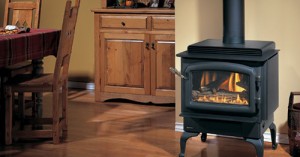8 FAQs about Gas Stoves
Purchasing a gas stove comes not only with a new way to heat your home, but like with any new device, it comes with questions. Here are some frequently asked questions that people have about their new gas stove.
- Can I burn wood in my gas stove? No. Burning anything other than natural or propane (LP) gas is a fire hazard. Only burn the fuel that your gas stove was designed for.
- Can I install a gas stove by myself? This answer can vary depending on the manufacture of the gas stove; however, the most common result is that the manufacture has a trained dealer that will do the installation to ensure all regulations, building codes, and safety requirements are met.
- How close can a gas stove be installed to the wall? Depending on the model that you choose it can vary. However, it is possible to get as close to 2 inches away from the wall with some units.
- What is BTU? BTU or British Thermal Unit is the standard energy measurement used with gas stoves. Each BTU unit is determined by the amount of thermal energy required to raise the temperature of one pound of water by one degree Fahrenheit.
- How much fuel does a gas stove consume? The consumption of fuel varies with each unit.
- How much does it cost to operate a gas stove? The cost of operation depends not only on the unit, but also on your location, utility company, and type of fuel used.
- Does a gas stove require floor protection? No, it does not. A gas stove can be installed on hardwood floor, carpet, and other types of flooring. However, it is recommended to not have a gas stove installed on carpet with long fabric.
- What is the difference between “direct vent,” “b-vent,” and “vent-free” gas stoves? These are three different terms that represent the three different ways of venting – supply combustion air to the stove and evacuate combustion gasses out of the house – the gas stove.
B-Vent Gas Stove – This is the traditional type “B” rigid pipe used to evacuate combustion gases. It can also be a certified flexible aluminum liner of the same diameter, inserted into an existing masonry chimney or a prefab chimney. A “B-vent” gas stove draws air from inside the house through ports located on the firebox. Usually, a fresh air source is provided as close as possible to the stove to ensure a constant supply of oxygen in the room, which is necessary to achieve a good combustion and an adequate draft. A fresh air source will also prevent negative pressure problems that can be caused by air moving equipment, such as a heat exchanger, a bathroom fan, or a range hood.
Direct Vent Gas Stove – This is a sealed installation. Direct vent pipes have a double wall. The main pipe draws air from outside the house to the firebox while the center pipe expels the combustion gases and moisture outside. It requires no chimney, and it is an independent, sealed, and safe evacuation system.
Vent-Free Gas Stove – Vent-free stoves use the room’s oxygen for combustion and expel combustion gases (H2O, CO2, CO, NO2, O2) inside the house. These types of stoves require no chimney. However, their use is illegal in the following states: Alaska, Massachusetts, Montana, Minnesota, Colorado, Utah, and California. Wisconsin restricts installation in homes built after 1980.
Resources: Regency, Rural Energy
Similar Articles:
- The Benefits of Owning a Gas Stove
- How to Properly Dispose of Fireplace and Wood Stove Ashes
- Important Facts about Gas Fireplaces
Wells & Sons Chimney Service offers a full-range of chimney cleaning and chimney repair services. They also sell and install wood and gas stoves. Their service area extends across Lansdale, Boyertown, Pottstown, Gilbertsville, Norristown, and surrounding Pennsylvania areas.









